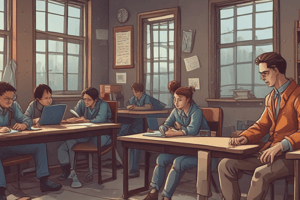Podcast
Questions and Answers
True or false:Compulsory education was introduced in the 19th century in the US.
True or false:Compulsory education was introduced in the 19th century in the US.
False (B)
True or false: Zero tolerance policies were introduced to replace corporal punishment and psychiatric asylums as means of managing school discipline.
True or false: Zero tolerance policies were introduced to replace corporal punishment and psychiatric asylums as means of managing school discipline.
True (A)
True or false: Zero tolerance policies involve flexible and lenient consequences for student misbehaviors on school grounds.
True or false: Zero tolerance policies involve flexible and lenient consequences for student misbehaviors on school grounds.
False (B)
True or false: Zero tolerance policies were influenced by the tough on crime movement and federal laws.
True or false: Zero tolerance policies were influenced by the tough on crime movement and federal laws.
True or false: School shootings have played no role in the implementation of zero tolerance policies.
True or false: School shootings have played no role in the implementation of zero tolerance policies.
True or false: The crack cocaine epidemic only impacted affluent communities.
True or false: The crack cocaine epidemic only impacted affluent communities.
True or false: Zero tolerance policies have resulted in decreased monitoring and security measures in schools.
True or false: Zero tolerance policies have resulted in decreased monitoring and security measures in schools.
True or false: Zero tolerance policies have led to no racial or punishment disparities whatsoever.
True or false: Zero tolerance policies have led to no racial or punishment disparities whatsoever.
True or false: The school-to-prison pipeline refers to the increasing contact students have with the criminal justice system as a result of zero tolerance policies and other factors.
True or false: The school-to-prison pipeline refers to the increasing contact students have with the criminal justice system as a result of zero tolerance policies and other factors.
True or false: The implementation of zero tolerance policies has been met with no negative reactions or concerns about the impact on learning.
True or false: The implementation of zero tolerance policies has been met with no negative reactions or concerns about the impact on learning.
Flashcards are hidden until you start studying
Study Notes
- Compulsory education was introduced in the US in the 20th century.
- Before zero tolerance policies, school discipline was managed through psychiatric asylums and corporal punishment.
- Zero tolerance policies involve predetermined and often severe consequences for student misbehaviors on school grounds.
- Zero tolerance policies were influenced by the tough on crime movement and federal laws.
- School shootings are uncommon but have contributed to the implementation of zero tolerance policies.
- The crack cocaine epidemic impacted poor communities and led to worries about adolescent gangs.
- Zero tolerance policies have resulted in increased monitoring and security measures in schools.
- Zero tolerance policies have led to racial and punishment disparities, particularly for minority students and those with disabilities.
- The school-to-prison pipeline refers to the increasing contact students have with the criminal justice system as a result of zero tolerance policies and other factors.
- The implementation of zero tolerance policies has been met with negative reactions and concerns about the impact on learning.
Studying That Suits You
Use AI to generate personalized quizzes and flashcards to suit your learning preferences.



